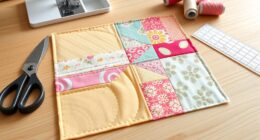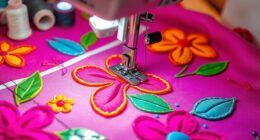If you’re passionate about elevating your sewing skills to couture level, these 14 top books are must-haves. They cover everything from precise tailoring, hand-sewing techniques, intricate patternmaking, to finishing touches used by fashion pros. With detailed instructions, visuals, and expert tips, you’ll gain confidence in creating high-end garments. Keep exploring, and you’ll discover how to transform basic projects into runway-worthy masterpieces. If you’re enthusiastic to improve, these titles will guide your couture journey step by step.
Key Takeaways
- Look for comprehensive guides with detailed techniques, illustrations, and step-by-step instructions tailored for serious sewists and professionals.
- Choose books that focus on high-end couture methods like fitting, pattern manipulation, and luxurious finishing techniques.
- Prioritize titles that include visual aids, DVDs, or online resources to enhance understanding of complex sewing processes.
- Select books with organized content, clear diagrams, and practical tips to support mastery of couture sewing skills.
- Consider resources that cover foundational skills plus advanced techniques, suitable for elevating craftsmanship to a couture level.
Couture Sewing Techniques: Revised and Updated
If you’re an experienced home sewist or professional looking to deepen your understanding of couture techniques, “Couture Sewing Techniques: Revised and Updated” is an invaluable resource. I started sewing just a year ago, focusing on small projects, but my passion grew when I made three corsets without patterns. Frustrated with my $60 Brother machine, I turned to hand-sewing to improve quality. Claire Shaeffer’s detailed book became my guide, offering step-by-step instructions, illustrations, and historical insights. While dense and text-heavy, it’s perfect for those committed to mastering couture techniques, helping me elevate my craftsmanship and produce professional-level garments.
Best For: experienced home sewists and professionals seeking to master couture sewing techniques and improve garment quality.
Pros:
- Highly detailed, comprehensive coverage of couture sewing methods and stitches.
- Rich in step-by-step instructions, illustrations, and historical context, enhancing learning.
- Ideal for sewists committed to elevating their craft and producing professional-level garments.
Cons:
- Dense, text-heavy format may be less accessible for complete beginners or casual sewists.
- Lacks modern, detailed photographs and visual aids found in newer sewing books.
- Requires a strong commitment to hand-sewing techniques, which may be challenging for those seeking quick results.
Couture Sewing: Tailoring Techniques
Couture sewing enthusiasts and professional tailors will find Claire Shaeffer’s book an invaluable resource for mastering advanced tailoring techniques. This extensive guide covers key couture elements like buttonholes, patch pockets, interfaced hems, converting darts to ease, tailored sleeves, fly zippers, and trouser hem measurements. With clear, step-by-step instructions, abundant photographs, and an accompanying DVD, it offers both detailed technical insights and visual demonstrations. Designed for serious sewers, it emphasizes precision, craftsmanship, and high-quality finishes. Whether you’re refining your skills or aiming for a professional couture look, this book provides the essential techniques to elevate your sewing to a new level.
Best For: serious sewers, fashion professionals, and couture sewing enthusiasts seeking detailed technical guidance and visual demonstrations to elevate their tailoring skills.
Pros:
- Comprehensive coverage of key couture techniques with clear, step-by-step instructions
- Abundant photographs and a DVD enhance understanding through visual demonstrations
- Highly praised for fostering precision, craftsmanship, and professional finishes
Cons:
- May be complex or overwhelming for complete beginners without foundational sewing experience
- Some content could be familiar to advanced sewers, offering limited new information
- The book’s focus on high-end techniques might be less relevant for casual or hobbyist sewists
Couture Sewing Techniques
Are you a serious sewer enthusiastic to elevate your craft beyond basic patterns? Couture Sewing Techniques is a detailed guide that dives into high-end construction, fit, and finishing methods. Even if you don’t pursue full hand couture, applying its tips can drastically improve your garments’ look and fit. The book covers essential tools, interfacing, reinforcements, and intricate seam finishes, helping you transform inexpensive fabrics into luxurious pieces. It emphasizes precise hand sewing and tailoring, encouraging confidence with expensive fabrics. Perfect for intermediate to advanced sewists, it offers inspiring visuals and clear instructions to bring couture-quality details into your everyday projects.
Best For: intermediate to advanced sewists seeking to incorporate couture techniques to elevate their garment construction, fit, and finishing details.
Pros:
- Offers comprehensive guidance on couture details, fit, and finishing techniques.
- Emphasizes precise hand sewing and tailored construction to improve garment quality.
- Includes inspiring visuals and detailed instructions suitable for serious sewers.
Cons:
- May be too advanced or detailed for complete beginners.
- Some images and examples are minimal or older, which might require additional references.
- Focuses on high-end construction methods that may be time-consuming for casual or quick projects.
Fashion Patternmaking Techniques: Haute Couture Vol. 2
Designed for seasoned patternmakers, “Fashion Patternmaking Techniques: Haute Couture Vol. 2” stands out as an invaluable resource for those seeking advanced inspiration and technical refinement. It emphasizes couture techniques such as creative darts, draping, and detailed garment elements like collars, sleeves, and skirts. The book relies heavily on high-quality visuals—illustrations and technical drawings—that are visually instructive but often lack step-by-step guidance. While it offers fundamental concepts, it doesn’t cover construction details or fabric shaping. Overall, it’s a highly regarded reference for its stunning imagery, though some find it limited for mastering complex garment construction.
Best For: experienced patternmakers seeking advanced couture inspiration and visual references to enhance their technical skills.
Pros:
- High-quality, detailed visuals and illustrations that are visually instructive
- Focuses on advanced couture techniques like draping, darts, and garment details
- Serves as an invaluable reference for professional patternmakers seeking inspiration
Cons:
- Lacks step-by-step instructions and detailed construction guidance
- Not suitable for beginners or those new to patternmaking techniques
- Visuals can be complex or difficult to interpret without supplementary explanations
Couture Sewing: Making Designer Trims
If you’re passionate about adding luxurious finishing touches to your garments, Couture Sewing: Making Designer Trims is an excellent resource to deepen your skills. This book offers detailed instructions on selecting and applying couture trims, complemented by over two hours of instructional DVD content. Claire Shaeffer’s clear illustrations, photographs, and step-by-step guides make complex techniques accessible. While it doesn’t teach how to create trims from scratch, it provides valuable insights into executing designer trims, especially for Chanel-inspired couture. The visuals and practical guidance make it ideal for advanced sewists seeking to elevate their finishing techniques and add that couture finesse to their projects.
Best For: advanced sewists and couture enthusiasts looking to enhance their finishing techniques with designer trims, especially those inspired by Chanel.
Pros:
- Provides detailed, step-by-step instructions with clear visuals and photographs.
- Includes over two hours of instructional DVD content for comprehensive learning.
- Focuses on applying couture trims with practical guidance, suitable for professional and experienced hobbyists.
Cons:
- Does not cover creating trims from scratch, which may require additional resources.
- Primarily centered on Chanel-inspired techniques, limiting coverage of other designer trims.
- Might be too advanced for beginners or sewists new to couture sewing.
Couture Sewing: The Couture Cardigan Jacket
Couture Sewing: The Couture Cardigan Jacket is an excellent resource for sewists who are serious about mastering high-end craftsmanship, especially those enthusiastic to learn couture techniques used in iconic Chanel jackets. This book offers detailed guidance on constructing a Chanel-style cardigan, focusing on fabric choices, pattern drafting, quilting, and finishing details like handworked buttonholes and edge finishes. It emphasizes the importance of toile fitting and advanced tailoring methods such as princess seams and chain weight insertion. With step-by-step instructions, illustrations, and a helpful DVD, it makes complex couture techniques accessible, inspiring sewists to elevate their skills and create authentic, luxurious jackets.
Best For: sewists who are committed to mastering high-end couture techniques, especially those interested in creating authentic Chanel-style cardigan jackets with detailed craftsmanship.
Pros:
- Provides comprehensive, step-by-step guidance with detailed illustrations and a DVD for visual learners.
- Covers advanced couture techniques such as princess seams, chain weight insertion, and handworked buttonholes.
- Offers valuable historical context and design insights to help achieve authentic Chanel jacket results.
Cons:
- Does not include pattern templates, requiring additional pattern purchases like Vogue V8804 for certain techniques.
- Estimated time investment is around 200 hours, which may be demanding for casual sewists.
- Some reviewers find certain instructions could be more detailed, particularly for complex steps.
Debbie Shores Sewing Room Secrets: Machine Sewing
Debbie Shores’ Sewing Room Secrets: Machine Sewing is an excellent resource for sewists of all skill levels who want to improve their machine techniques with clear, step-by-step guidance. Her friendly, approachable style makes complex concepts easy to understand, whether you’re a beginner or an experienced sewer. The book covers a wide range of topics, offering practical tips, inspiring projects, and techniques like shirring and tote bag making. Many readers use her instructions as a refresher or to learn new skills, and her online tutorials complement the book perfectly. Overall, her thorough coverage and clear explanations make this a must-have for anyone looking to master machine sewing.
Best For: sewists of all skill levels seeking clear, practical guidance to improve their machine sewing techniques and complete inspiring projects.
Pros:
- Clear, step-by-step instructions that are easy to follow for beginners and experienced sewists alike
- Covers a wide range of topics including techniques like shirring and tote bag making, offering versatile learning options
- Combines book content with online tutorials for a comprehensive and accessible learning experience
Cons:
- Some advanced techniques may require supplementary resources for in-depth mastery
- The book’s focus on machine sewing might not cover hand-sewing or specialty machine tips extensively
- Readers looking for highly detailed technical specifications may find the coverage somewhat general
Professional Sewing Techniques for Designers
Are you a designer seeking precise, reliable techniques to elevate your garment construction? This book offers exhaustive, step-by-step instructions covering almost all sewing techniques, fit, pattern drafting, and alterations. Its detailed line drawings and clear explanations make complex processes accessible, whether you’re a beginner or advanced sewist. It’s especially valuable for refining fit, modifying patterns, and handling fabrics expertly. The logical organization and practical design ideas inspire confidence. While it may lack some metric measurements, it remains a top resource for those aiming for professional results. This book truly serves as a thorough reference, helping you achieve high-quality, couture-level garments with precision.
Best For: fashion designers, dressmakers, and serious sewists seeking comprehensive, precise techniques to improve garment construction, fit, and pattern modification.
Pros:
- Extensive, step-by-step instructions with clear line drawings and diagrams for complex techniques
- Covers a wide range of sewing skills, including fit, pattern drafting, and fabric handling
- Well-organized layout and logical flow enhance usability and quick reference
Cons:
- Lacks metric measurements, which may require conversion for some users
- Some explanations can be vague or require prior sewing knowledge to fully understand
- Minimal coverage of certain techniques like serging or finishing details
PatternReview.com 1,000 Sewing Tips and Shortcuts
If you’re looking for a practical, easy-to-navigate resource that can instantly improve your sewing skills, PatternReview.com’s “1,000 Sewing Tips and Shortcuts” is an excellent choice. This well-organized guide offers over 1,000 tips, shortcuts, and illustrations suitable for all skill levels. It covers everything from pattern preparation and fitting to finishing details and troubleshooting common issues. Designed for quick reference, it’s perfect for hobbyists, home sewers, and professionals alike. Many experienced sewers find fresh ideas and reminders that boost efficiency and quality. Paired with the PatternReview.com community, it provides continuous learning and inspiration for every sewing journey.
Best For: sewing enthusiasts of all skill levels seeking a comprehensive, easy-to-navigate reference to improve techniques, organization, and project quality.
Pros:
- Over 1,000 practical tips, shortcuts, and illustrations for quick and efficient learning
- Suitable for beginners through advanced sewers, offering advice for various techniques and tools
- Well-organized format with visual aids that facilitate easy access to specific topics
Cons:
- Some illustrations may lack clarity in the Kindle version, impacting visual understanding
- The book is primarily a reference guide, so it may not provide in-depth explanations for complex techniques
- A few users wished for more visual content to complement the tips and diagrams
Alabama Studio Sewing + Design Guide
The Alabama Studio Sewing + Design Guide stands out as an ideal resource for crafters who want to deepen their hand sewing skills and embrace sustainable, handmade fashion. It offers detailed instructions, clear stitch charts, and inspiring close-up photos that make techniques accessible for all skill levels. The book emphasizes embellishments like embroidery, applique, and beading, encouraging creativity and originality. Designed for simple, forgiving fabrics like cotton jersey, it promotes eco-friendly practices through reusing thrifted garments and sustainable materials. With projects covering basic garments and accessories, it’s perfect for those seeking to craft timeless, personalized pieces while honoring craftsmanship and mindful consumption.
Best For: crafters and sewists of all skill levels interested in sustainable, handcrafted fashion with an emphasis on embellishment techniques and traditional craftsmanship.
Pros:
- Clear instructions, stitch charts, and large photos make techniques accessible for beginners and experienced crafters alike.
- Emphasizes eco-friendly practices, reuse of thrifted garments, and sustainable materials promoting slow fashion.
- Offers a versatile array of projects and embellishment techniques that inspire creativity and originality.
Cons:
- Patterns are designed for forgiving fabrics like cotton jersey, which may require modifications for other materials.
- Might be challenging for plus-size individuals without additional pattern alterations or adjustments.
- The detailed, time-consuming nature of hand sewing projects may not appeal to those seeking quick or mass-produced results.
Claire Shaeffers Fabric Sewing Guide
Looking for a sewing guide that balances thorough detail with practical guidance? Claire Shaeffer’s Fabric Sewing Guide is exactly that. With over 500 pages, it covers everything from fiber types to advanced sewing techniques, making it perfect for beginners and pros alike. The book’s organized into color-coded sections and includes helpful hints, diagrams, and photographs to clarify complex concepts. It dives deep into fabric identification, handling specialty textiles, and achieving professional finishes. Whether you’re troubleshooting puckering or choosing the right interfacing, this guide offers invaluable insights from Claire’s decades of experience. It’s a must-have reference to elevate your sewing craft.
Best For: sewists of all skill levels seeking a comprehensive, detailed reference to improve their fabric handling, sewing techniques, and garment finishing skills.
Pros:
- Extensive coverage of fabric types, handling, and technical sewing methods for professional results
- Well-organized with color-coded sections, diagrams, photographs, and helpful hints for easy navigation
- Valuable for both beginners and advanced sewists looking to deepen their understanding and refine their craft
Cons:
- Very large and heavy, which may be cumbersome for casual reference or quick look-ups
- Requires dedicated study time due to its detailed and technical content
- Price may be high compared to more basic sewing manuals
Simple Serger Sewing
Simple Serger Sewing stands out as an ideal resource for beginners enthusiastic to master their serger machines and expand their sewing skills. This book features attractive design, large color photos, and projects suitable for various skill levels. I love how it covers everything from baby items to home decor, emphasizing practical applications of serger techniques. The step-by-step instructions are straightforward, making it perfect for those new to serging. Whether you’re sewing T-shirts or gift totes, this book builds confidence and helps you achieve professional finishes. It’s a must-have for anyone eager to enhance their sewing projects with serger skills.
Best For: beginners and sewists eager to learn and improve their serger skills across a variety of projects from baby items to home decor.
Pros:
- Clear, easy-to-follow step-by-step instructions ideal for beginners
- Includes a wide range of practical projects for different skill levels
- Attractive design with large color photos enhances the learning experience
Cons:
- Some projects may seem intimidating for absolute beginners at first
- May require purchased patterns for some projects, adding to the cost
- Less advanced techniques might not fully satisfy experienced sewers looking for complex methods
BurdaStyle Modern Sewing – Wardrobe Essentials
If you’re a beginner or someone new to Burda patterns, the “BurdaStyle Modern Sewing – Wardrobe Essentials” book offers clear, detailed instructions that make sewing accessible. It features about 19 patterns, mainly simple tops, with some jackets, pants, and a dress, pulling from international Burda magazine issues. The instructions are beginner-friendly, with helpful illustrations and tips, though some steps can be confusing. The pattern sheets are organized but require tracing. While it’s great for practicing basic techniques and expanding your wardrobe with casual pieces, it lacks classic essentials like jeans or trench coats. Overall, it’s a valuable resource for beginners enthusiastic to learn and experiment.
Best For: beginners or those new to Burda patterns seeking clear instructions, helpful tips, and practice with casual wardrobe pieces.
Pros:
- Clear, detailed, and beginner-friendly sewing instructions with helpful illustrations
- Organized pattern sheets that improve upon magazine versions, facilitating easier tracing
- Useful tips on pattern adjustments, seam finishing, and sewing techniques for novices
Cons:
- Limited variety of garment types, mainly basic tops with few wardrobe essentials like jeans or trench coats
- Some patterns are repetitive and cater more to slim, young body types, reducing versatility
- Pattern assembly and tracing can be tedious, especially for those who prefer instant pattern access
Pattern Magic 2
Pattern Magic 2 is an ideal choice for experienced pattern designers and fashion enthusiasts enthusiastic to push the boundaries of traditional garment construction. It offers advanced techniques for transforming basic slopers into innovative, geometric, and pleated designs. The book emphasizes pattern manipulation over ready-to-wear templates, showcasing detailed illustrations and technical drawings that inspire creativity and artistic exploration. While not a sewing manual, it’s perfect for those wanting to develop original, well-fitting patterns and explore complex shapes. Many appreciate its aesthetic appeal and technical depth, making it a valuable resource for anyone passionate about haute couture-inspired pattern development and pushing fashion boundaries.
Best For: experienced pattern designers and fashion enthusiasts eager to explore complex, innovative pattern manipulation and haute couture-inspired designs.
Pros:
- Highly detailed illustrations and technical drawings that inspire creativity and deepen understanding of pattern transformation.
- Focuses on artistic pattern development, encouraging conceptual thinking beyond traditional garment construction.
- Aesthetic presentation makes it a beautiful coffee table book and conversation starter, appealing to art and design lovers.
Cons:
- Not a sewing manual; does not include ready-to-sew patterns or step-by-step sewing instructions.
- Designed for advanced users; beginners may find the techniques challenging without prior pattern drafting experience.
- Some patterns are highly unconventional and may not be directly wearable, potentially limiting practical application.
Factors to Consider When Choosing Couture Sewing Technique Books
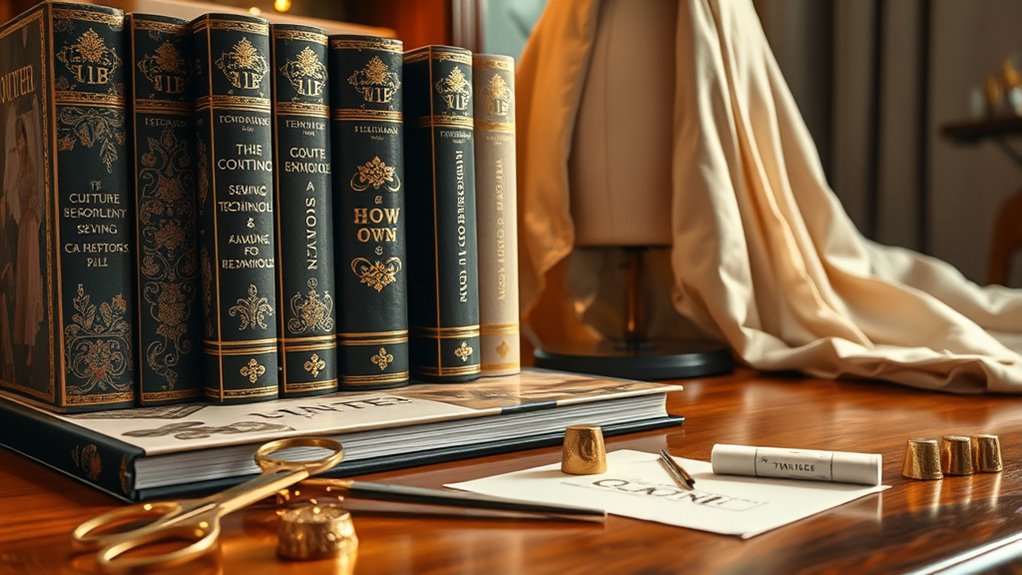
When selecting couture sewing technique books, I always consider how well they match my skill level to make sure I can follow along comfortably. I look for clear visual instructions and thorough details that deepen my understanding of techniques. Additionally, I prefer books with organized layouts and practical applications that help me translate what I learn into real projects.
Skill Level Compatibility
Choosing the right couture sewing technique book hinges on matching its content to your skill level. If you’re a beginner, look for books that offer clear explanations, step-by-step instructions, and visual aids suited for novices. These will help you build a solid foundation without feeling overwhelmed. Intermediate and advanced sewists should seek out books with more detailed instructions, sophisticated techniques, and a focus on couture finishing or pattern manipulation to challenge their skills. It’s important to check whether the book assumes prior knowledge or covers foundational techniques, ensuring it aligns with your current abilities. Selecting a book that matches your skill level will make learning more effective and enjoyable, preventing frustration and encouraging steady progress in your couture sewing journey.
Visual Instruction Quality
High-quality couture sewing books rely heavily on visual instruction to effectively communicate complex techniques. Clear images, detailed diagrams, and close-up photographs are crucial for demonstrating stitches, finishes, and construction methods. When selecting a book, I look for visuals that accurately depict each step, making it easier to follow along. Well-designed visuals should complement the written instructions without overwhelming me, striking a balance between detail and clarity. Sharp, high-resolution images are essential; blurry or poorly organized visuals can hinder learning and lead to mistakes. I also appreciate close-ups that highlight intricate details, helping me replicate professional results. Overall, a book with excellent visual instruction boosts my confidence and understanding, making the sewing process more precise and enjoyable.
Technique Depth and Detail
The depth of detail in a couture sewing book is essential for building true mastery of complex techniques. I look for books that provide extensive step-by-step instructions paired with detailed illustrations, ensuring I understand each process thoroughly. A thorough book covers various stitches, finishing methods, and construction nuances, giving me a complete picture of couture sewing. I also value titles that include historical context and explain the reasoning behind techniques, which deepens my understanding beyond mere execution. Troubleshooting guidance and tips for adapting techniques to different fabrics and garment types are invaluable, helping me navigate challenges confidently. Additionally, books that offer multiple approaches and variations for key techniques enable greater flexibility, fostering my growth as a skilled couture sewer.
Book Organization & Layout
A well-structured couture sewing book makes it much easier to learn and apply complex techniques. Clear chapter divisions, headings, and logical progression help you locate information quickly. Visual cues like diagrams, photographs, and illustrations complement the text, making intricate steps easier to grasp. Consistent formatting—such as uniform font sizes, styles, and spacing—enhances readability, especially during detailed instructions. An intuitive organization groups related techniques, allowing you to build skills gradually and understand advanced methods more effectively. Additional features like indexes, glossaries, and quick-reference charts support efficient navigation and reinforce your understanding of couture sewing principles. Overall, a thoughtfully organized layout keeps your learning focused and minimizes frustration, making your sewing journey more enjoyable and productive.
Practical Application Focus
When choosing a couture sewing technique book, focusing on practical application guarantees you gain skills that work in real projects. Look for books that emphasize hands-on techniques with clear, step-by-step instructions you can follow easily. Visual aids like detailed illustrations and photographs are essential—they make complex couture methods more understandable. Prioritize resources covering key skills such as interfacing, precise hand stitching, and finishing details to build high-quality garments. A good book should also guide you through fitting, pattern adjustments, and fabric handling, ensuring professional results. Most importantly, choose a book that encourages experimentation and adaptation, offering practical tips applicable across different fabrics and styles. This focus on real-world application helps turn techniques into confident, finished garments.
Frequently Asked Questions
How Do I Select the Best Couture Sewing Book for My Skill Level?
To choose the best couture sewing book for my skill level, I first assess my current knowledge and experience. I look for books tailored to beginners if I’m new, or more advanced ones if I’ve got some experience. I read reviews and check the table of contents to see if the techniques match my goals. Picking a book that challenges me just enough keeps me motivated and helps me improve.
Are There Specific Books for Beginner vs. Advanced Couture Techniques?
Jumping into couture sewing isn’t like sending a telegram; it’s more like mastering virtual reality! Yes, there are books tailored for beginners, like “Couture Sewing Techniques” by Claire Shaeffer, which break down fundamentals step-by-step. For advanced sewers, books like “The Art of Couture Sewing” plunge into intricate details and complex techniques. I recommend starting with beginner guides and progressing as your skills grow—it’s the best way to learn!
Which Books Cover Sustainable or Eco-Friendly Couture Sewing Practices?
I recommend checking out books like “Sustainable Fashion and Textiles” by Kate Fletcher and “Eco-Chic: The Fashion Paradox” by Sandy Black. These titles explore eco-friendly couture techniques, focusing on sustainable fabrics, zero-waste design, and ethical production practices. I find them inspiring and practical, offering valuable insights into creating beautiful, environmentally conscious garments. They’re perfect if you want to blend high fashion with responsible, eco-conscious sewing methods.
Do These Books Include Patterns or Only Technical Instructions?
These books primarily focus on technical techniques, offering detailed instructions that elevate your sewing skills. While some might include patterns for practice, their main goal is to teach craftsmanship, not provide ready-to-wear templates. I find that they’re perfect for honing your hands-on talent and understanding the art behind couture sewing. If you’re seeking skill-building, these texts are treasure troves—patterns are more of an added bonus than a core feature.
How Frequently Are These Couture Sewing Books Updated With New Techniques?
These couture sewing books are updated sporadically, often depending on the author or publisher. I’ve noticed some receive new editions every few years, especially when new techniques or trends emerge. While some classic texts stay the same, others get refreshed to include the latest innovations in sewing and design. I recommend checking the publication date before buying to make sure you’re getting the most current information.
Conclusion
If you’re serious about mastering couture sewing, these books are your golden ticket. They cover everything from intricate tailoring to stylish trims, helping you elevate your skills step by step. Remember, Rome wasn’t built in a day, so don’t rush the process. Immerse yourself, practice consistently, and watch your sewing become truly couture-worthy. With dedication and the right resources, you’ll soon be turning heads with your one-of-a-kind creations.
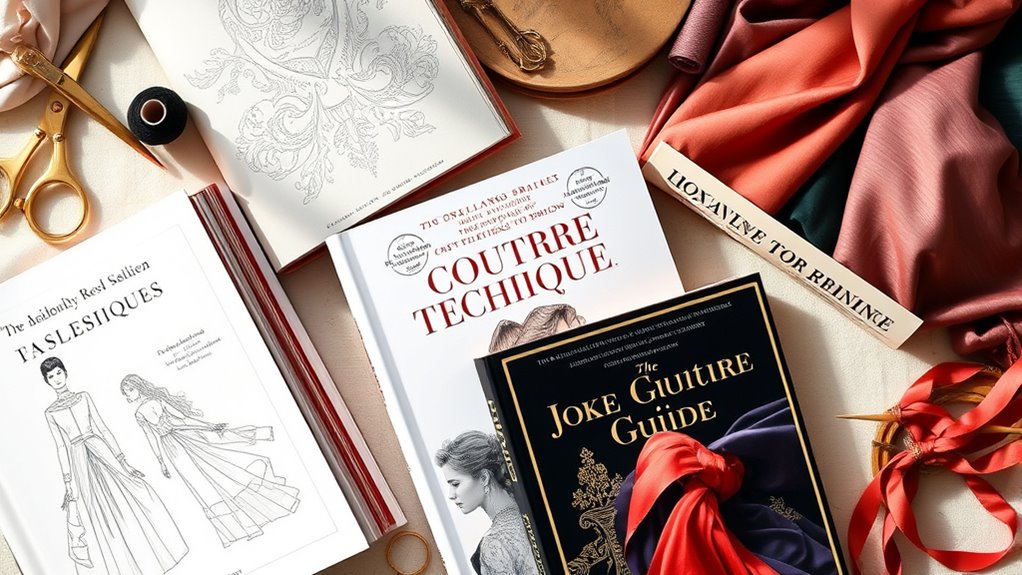
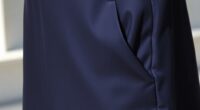




![Fashion Patternmaking Techniques - Haute Couture [vol. 2]: Creative Darts,](https://m.media-amazon.com/images/I/4115eCD2OiL._SL500_.jpg)















